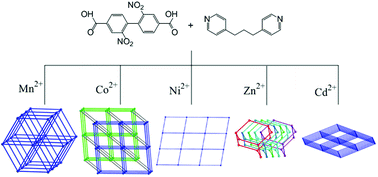Coordination polymers constructed by 1,3-bi(4-pyridyl)propane with four different conformations and 2,2′-dinitro-4,4′-biphenyldicarboxylate ligands: the effects of metal ions†
Abstract
Five coordination

* Corresponding authors
a
State Key Laboratory of Inorganic Synthesis and Preparative Chemistry, College of Chemistry, Jilin University, Changchun, People's Republic of China
E-mail:
zshi@mail.jlu.edu.cn
Fax: +86 431 85168624
Tel: +86 431 85168662
Five coordination

 Please wait while we load your content...
Something went wrong. Try again?
Please wait while we load your content...
Something went wrong. Try again?
B. Li, G. Li, D. Liu, Y. Peng, X. Zhou, J. Hua, Z. Shi and S. Feng, CrystEngComm, 2011, 13, 1291 DOI: 10.1039/C0CE00252F
To request permission to reproduce material from this article, please go to the Copyright Clearance Center request page.
If you are an author contributing to an RSC publication, you do not need to request permission provided correct acknowledgement is given.
If you are the author of this article, you do not need to request permission to reproduce figures and diagrams provided correct acknowledgement is given. If you want to reproduce the whole article in a third-party publication (excluding your thesis/dissertation for which permission is not required) please go to the Copyright Clearance Center request page.
Read more about how to correctly acknowledge RSC content.
 Fetching data from CrossRef.
Fetching data from CrossRef.
This may take some time to load.
Loading related content
